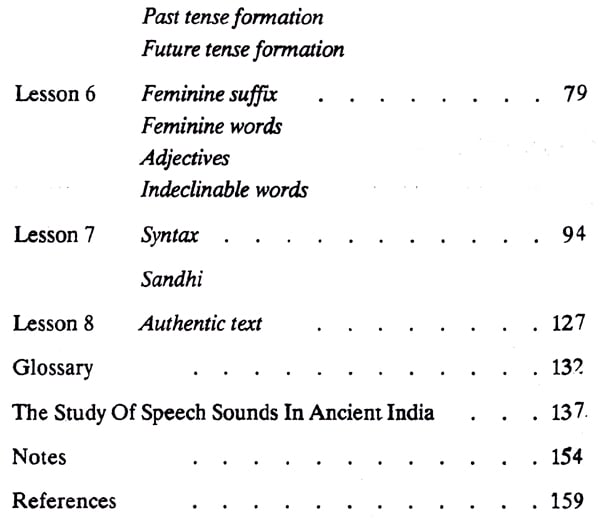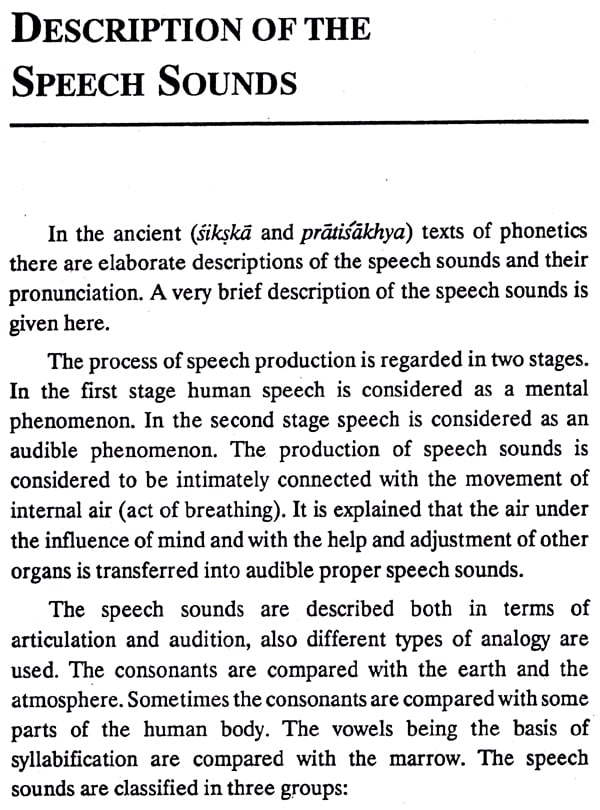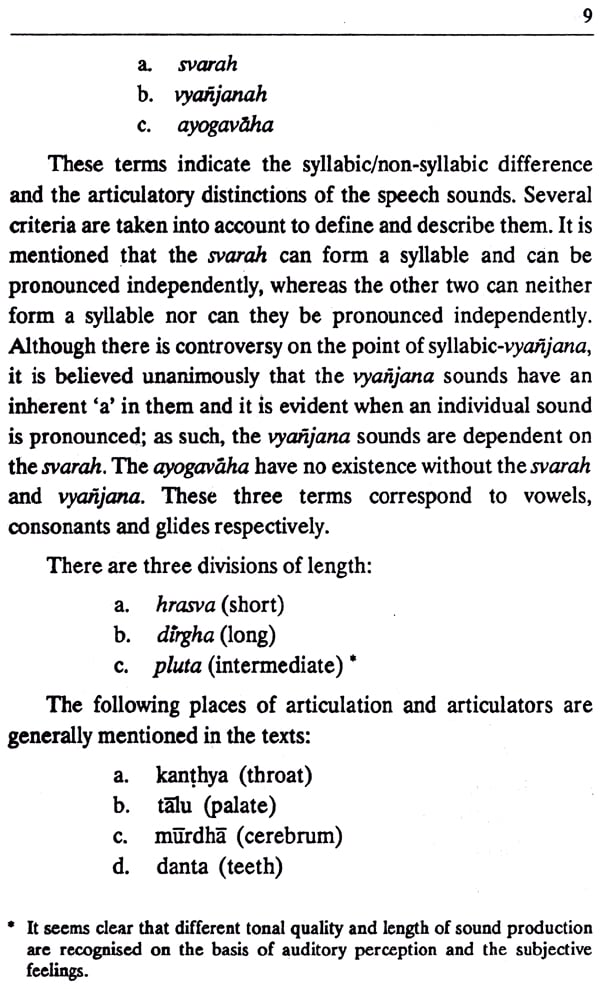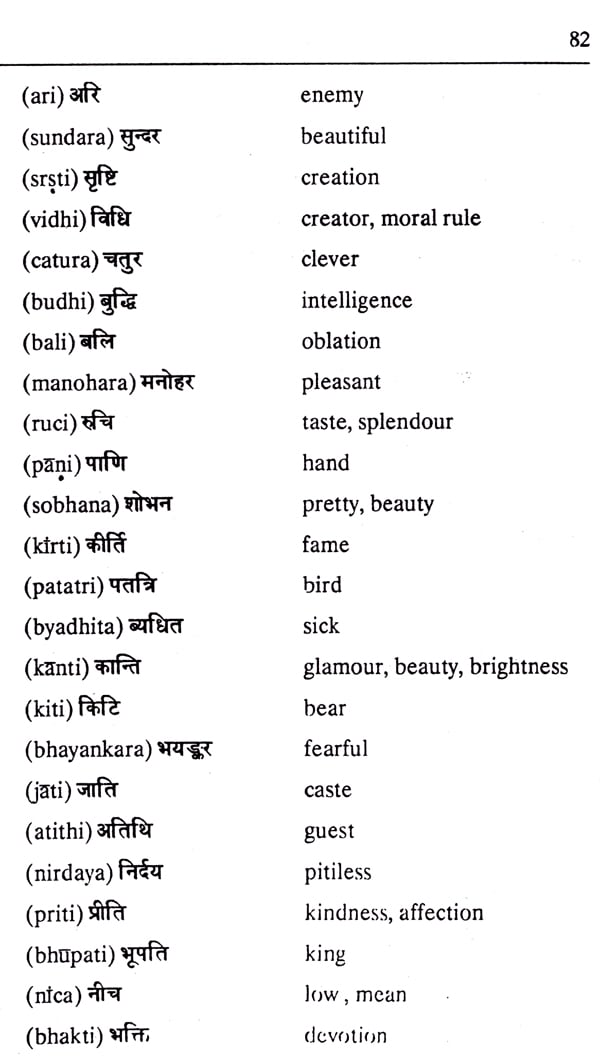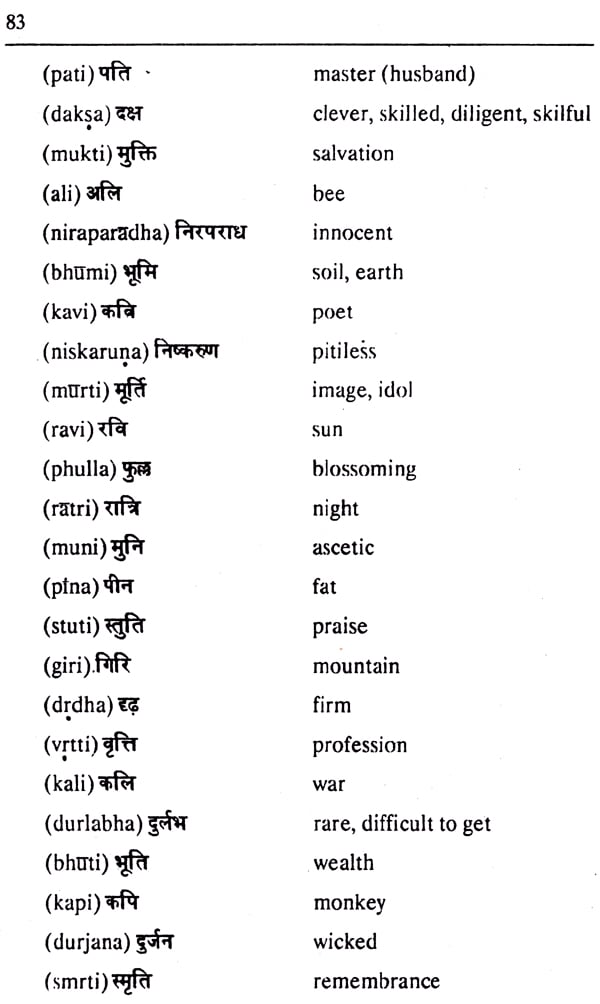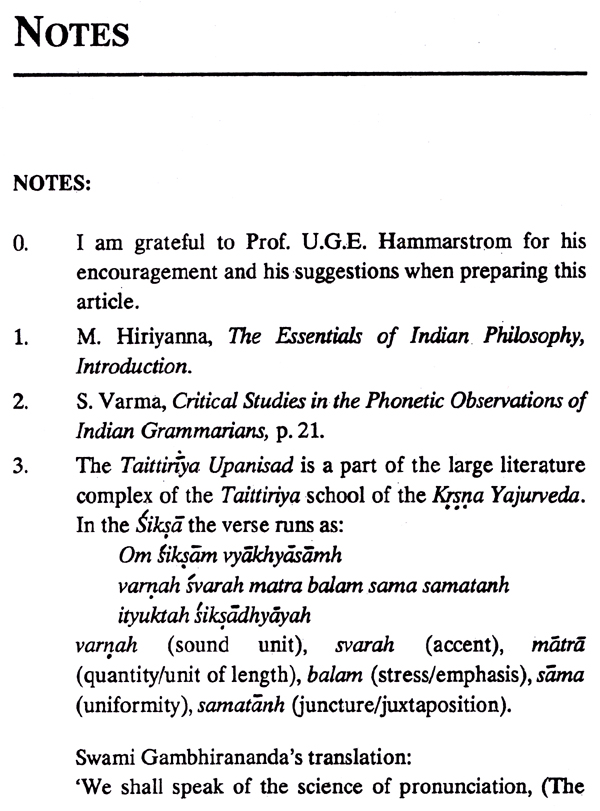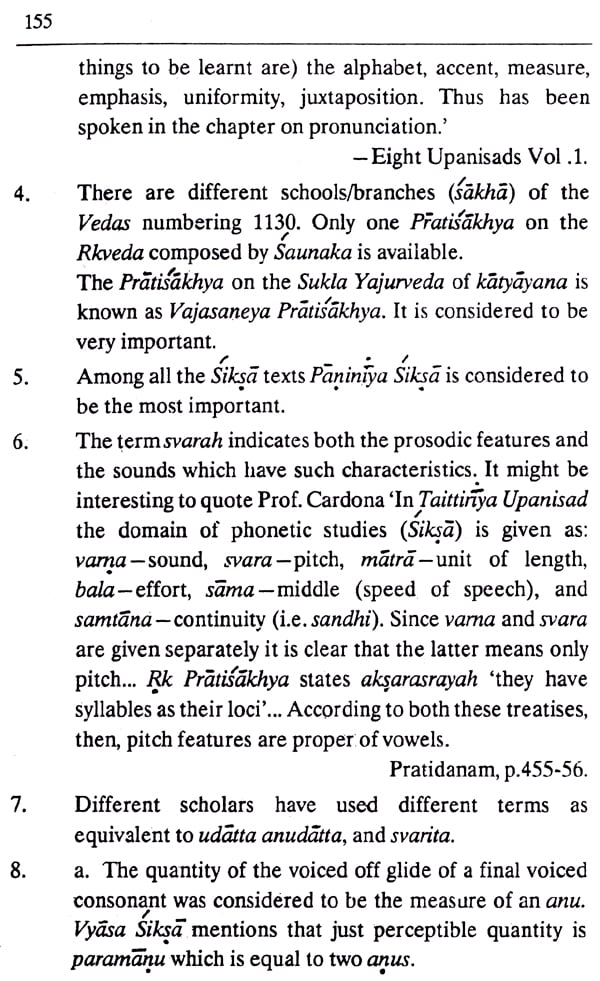
Bhasabodhini (A Sanskrit Primer)
Book Specification
| Item Code: | NAS161 |
| Author: | Malaya Gangopadhyay |
| Publisher: | Sri Satguru Publications |
| Language: | Sanskrit Text Transliteration with English Translation |
| Edition: | 1991 |
| ISBN: | 817030248x |
| Pages: | 168 |
| Cover: | PAPERBACK |
| Other Details | 9.00 X 5.50 inch |
| Weight | 210 gm |
Book Description
The main aim of this book is to gain access in reading and understanding the written texts, It is a beginners' course. Assuming that the learners have no prior knowledge of this language, we have introduced the script, explained the sound value and word formation. With controlled vocabulary and limited grammar the process of simple sentence formation is explained in the book.
The dual systems of sound and meaning at different levels are presented in the book to explain the structural pattern of the language. The author have tried to represent the characteristics of the Sanskrit language at the levels of phnology, morphology and syntax, Once the regulairites of the patterns are grasped, the sound-symbol-meaning association is perceived. It is hoped that an immediate gratification and self-fulfilment will be achieved following the structured lessons and exercises provided in the course material.
Dr. Malaya Gangopadhyay is presently teaching in Australia.
The work Bhsabodhini will be presented in a series of three books. The present book can be used as a teaching manual for a course. Alternatively, a student (learner) can use it independently together with a pronunciation tape.
Originally these lessons were prepared for the beginning students in Sanskrit at the Council of Adult Education and at the Department of Indian Studies, Melbourne University (Australia).
There are many Sanskrit primers available but I did not find a suitable one for the groups I taught between 1983 and 1985. Their needs, aspirations, purposes and motivations were different. Assessing the situation an attempt has been made to present the language in a comprehensible manner. The arrangement of the lessons is self-explanatory. By introducing the phonological characteristics, limited vocabulary items, elementary grammar and restricted sentence patterns a simple approach is adopted.
Other books in the series are based on themes. The historical and cultural prespectives have been discussed. In addition, the necessary theoretical aspects of language teaching have been dealt with.
My thanks go to the Liberal Studies and Audiovisual Departments of CAE. Also, I am indebted to all my students past and present. Without their specific needs and enquiries I would not have ventured to produce the teaching materials. I am thankful to Adhyapika Dipika Sarbadhikari, lecturer in Sanskrit at Scottish Church College, Calcutta, for reading the manuscript. I am thankful to Adhyapaka Pabitra Chakravarty, Dept. of Sanskrit at Krishnagar Govt. College for his kind suggestions. I express my gratitude to Adhyapaka Anil Sen Gupta of Scotish Church College, for his encouragement. My sincere gratitude is due to Prof. Jan Gonda, well known Indologist for his thoughtful advice and comments. Finally my thanks go to the Indian Books Centre for their acceptance of the manuscript for publication.
This series has been dedicated to the memory of Late Prof. Purnachandra Biswas, a dedicated follower of the bhakti tradition who taught Physics. I received his blessing from my childhood.
All languages are genuinely complex systems of sound and meaning. We take the premise that language is an intrinsic aspect of human inheritance. Also we believe that through the learning of a language a learner can understand the sociological and psychological conventions of a community. Language and culture are closely associated. The worlds of ideas, relationships, names and forms are dependent on language. The experience of the past is recorded in it. The way a community perceives the world is reflected in its language.
In learning a classical language one goes beyond the utilitarian means of day to day activities. Modern Language theory maintains that language in all its forms is acquired and developed through usage, and the formalised study of rules and vocabulary are a relatively weak incentive to the learners. It may be so for first language learning. But the needs of the second language or foreign language (including the classical language) learner are different. Therefore this theoretical assumption is not appropriate or applicable to their learning. Consequently the method of teaching and context are different in learning a foreign language or a classical language.
However, learning a language means making a conscious effort in drill, memorization, exercise and use. Both mental and physical processes are involved in learning this abstract system of sound and meaning which is called language. Learning a classical language requires formal instruction, since the purpose is to read the literature and develop certain attitudes.
The main aim of this course is to gain access in reading and understanding the written texts. It is a beginners' course. Assuming that the learners have no prior knowledge of this language, we have introduced the script, explained the sound value and word formation. With controlled vocabulary and limited grammar the process of simple sentence formation is explained in our course material.
Our approach is a mixture of different approaches. In learning a classical language like Sanskrit, the emphasis more or less falls on the structural side; it is difficult to produce specified situations or a variety of situations in a beginner's course. The grammar translation method cannot be avoided completely because the meaning has to be conveyed through English.
The dual systems of sound and meaning at different levels are presented in our course material to explain the structural pattern of the language. We have tried to present the characteristics of this language at the levels of phonology, morphology and syntax. Once the regularities of patterns are grasped, the sound-symbol-meaning association is perceived. It is hoped that an immediate gratification and self-fulfilment will be achieved following the structured lessons and exercises provided in our course material.
We have attempted to make the system and structure accessible, visible and learnable in graded lessons of three units.
But it should be borne in mind that a brief spell of language learning is not sufficient to attain a high level of fluency or comprehension of the total complexity of a language system.
Sanskrit is the language of ancient India. Muni, the ancient grammarian who characterized the linguistic features of this language in his 4000 sutras, employed the names of Chandas and blfas-a.By the term Chandas he meant the language of the Vedas, and the other term indicated the language spoken at that time. Presumably this spoken language belonged to the higher strata of the community.
A standardised form of this language was used in literature, which is commonly known as Classical Sanskrit. However, the term Sanskrit is an English or Western adoption. The actual (proper) term is samskrta, which means the cultivated, polished, grammatically correct variety (register) of the language. In its long history starting from 1500 B.C., it has passed through several stages of development enriching and changing itself with the passing of time.
It is the source language of all Indo-Aryan Languages (old and modern). We must remember that it is not a dead language, although it has little commercial or economic value in contemporary life. A large number of Indians study and practise Sanskrit. Technical terms and new vocabulary are coined from Sanskrit. It is regularly used in religious and cultural rituals and members of a small community in India use this language in their everyday life activities.
Indians pay their homage to the great grammarians Mini and his commentator Patanjali when they study Sanskrit language. To give a traditional touch we would recommend that the teacher and pupils should pay their' homage the way the Indians do, and chant Santipdtha at the beginning and end of each session.
In our course we have introduced a few hymns from different texts. The chanting of hymns is introduced mainly to facilitate pronunciation. From our experience we understand that the chanting of hymns is readily acceptable by adult learners, as the group can participate actively and it is enjoyable. Regarding the pronunciation one word may be mentioned here, that in India Sanskrit pronunciation varies from one region to another, although distinct sound values are maintained. The main sources of grammar followed in Sanskrit teaching also vary, mostly the simplified versions of Si ddliantakaumudi, Bopadeva, Laghu-siddhaitakaumudi are followed. Some details may be provided later.
Our course material represents the commonly used simpler grammar. Some examples are borrowed from various texts. As spelling and pronunciation are closely related in this language, the knowledge of the place of articulation and effort (sthaia and prayatna) is necessary. So we have given a short description of the speech sounds.
The key notions and grammatical concepts are explained mainly within a structural framework. A beginners' course can only offer a fragment of a language.
THE TRADITIONAL VIEW
In the Sanskrit tradition (Brahmanical tradition) the origin of language is considered to be divine. Language is understood as the phonetic expression of the inherent intellectual faculty of the Human mind.
**Contents and Sample Pages**

